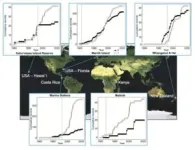(Press-News.org) Marine Protected Areas (MPAs) are having a positive spillover effect, producing more “trophy-size” fish just outside of the fully protected areas, and the effect is growing stronger over time. That’s according to research led by University of Hawaiʻi at Mānoa scientists at the Hawaiʻi Institute of Marine Biology (HIMB) published today in Science Advances. The research provides the first global assessment of the benefits of MPAs. “Trophy-size” refers to fish that are exceptionally long or heavy and are considered a rare, prized catch.
“This standardized global assessment illustrates the benefits that MPAs provide for recreational anglers, confirming the effectiveness of MPAs in enhancing fish biomass and local fisheries,” shares Simone Franceschini, Principal Investigator of the study and a Postdoctoral Researcher at HIMB. “Our study found that MPAs may take more than 20 years to show tangible spillover effects in the adjacent areas, which helps to set realistic expectations about the timeframe over which a marine reserve can be expected to have this type of effect on surrounding fisheries.”
The Hawaiian archipelago has 13 state and federal MPAs (complete list below). The state protected areas, called Marine Life Conservation Districts, are managed by the State of Hawaiʻi Division of Aquatic Resources.
Marine protected areas have been identified as one of the most effective tools for securing marine biodiversity, but until now the global impact of MPAs on local, recreational fisheries has been unclear. This study provides globally-relevant guidance for what management agencies, conservation practitioners, and, importantly, recreational fishers can expect over the long term from the establishment of MPAs.
The research builds on the work of Callum Roberts et al., a team of scientists who twenty years ago conducted a study in Florida and discovered that the cumulative number of trophy fish caught near an MPA (within 100km of its boundary) rises rapidly between 12-30 years after MPA establishment.
“In this paper, we test whether the results of one of the most well-known studies of MPA impacts on recreational fishers can be replicated at a global scale,” explains Elizabeth Madin, co-author of the paper and Associate Professor at HIMB. “We show that, on average, highly-protected marine ecosystems produce tangible, real-world, long-term benefits for recreational fishers, resulting in a win-win situation for nature and people alike. Nonetheless, it’s important to realize that not every MPA will have the same spillover effects, and that successful MPAs have been shown to depend on community support, enforcement, and effective fisheries management.”
The findings of this study hold important implications for the future of MPAs and the global “30x30” marine conservation initiative, which aims to protect 30% of the world’s oceans by 2030.
“These results provide evidence-based guidance that can help ensure the successful implementation and long-term support of MPAs worldwide,” says co-author John Lynham, who is a Professor of Economics at University of Hawaiʻi at Mānoa. “It's intriguing to note that various MPAs around the world, despite their differing sizes and characteristics, have demonstrated a similar positive spillover effect and a similar ‘wait time:’ roughly 20 years.”
The study also underscores the importance of setting practical expectations about the benefits of marine reserves for local fisheries. While MPAs can lead to substantial increases in the abundance of large fish, these benefits often require decades to materialize. This requires patience and long-term commitment from policymakers and local communities to maintain support for conservation efforts. Nonetheless, as Callum Roberts, lead author of the original 2001 study upon which the current study was built, points out, “Local fishers will see benefits to their catches from spillover of smaller fish long before that spillover becomes detectable in the form of large trophy fish, which take longer to reach record breaking sizes. So, well protected MPAs can help support local livelihoods within a decade of creation.”
Marine Protected Areas in Hawaiʻi
Federally protected marine areas
Hawaiian Islands Humpback Whale National Marine Sanctuary
Papahānaumokuākea Marine National Monument
State protected marine areas
Hanauma Bay Marine Life Conservation District, Oʻahu
Pūpūkeaahu Marine Life Conservation District, Oʻahu
Waikīkī Marine Life Conservation District, Oʻahu
Kealakekua Bay Marine Life Conservation District, Hawai'i
Lapakahi Marine Life Conservation District, Hawai'i
Old Kona Airport Marine Life Conservation District, Hawai'i
Waialea Bay Marine Life Conservation District, Hawai'i
Wai'ōpae Tidepools Marine Life Conservation District, Hawaii
Honolua–Mokulē'ia Marine Life Conservation District, Maui
Mānele–Hulopo'e Marine Life Conservation District, Maui
Molokini Shoal Marine Life Conservation District, Maui
END
Global study by Hawaiʻi Institute of Marine Biology demonstrates benefit of marine protected areas to recreational fisheries
2024-07-19
ELSE PRESS RELEASES FROM THIS DATE:
Researchers clarify how soft materials fail under stress
2024-07-19
CHAMPAIGN, Ill. — Understanding how soft materials fail under stress is critical for solving engineering challenges as disparate as pharmaceutical technology and landslide prevention. A new study linking a spectrum of soft material behaviors — previously thought to be unrelated — led researchers to identify a new parameter they call the brittility factor, which allows them to simplify soft material failure behavior. This will ultimately help engineers design better materials that meet future challenges.
University of Illinois Urbana-Champaign chemical and biomolecular engineering professor Simon Rogers and graduate student Krutarth Kamani specialize ...
Revolutionizing the abilities of adaptive radar with AI
2024-07-19
DURHAM, N.C. – The world around us is constantly being flash photographed by adaptive radar systems. From salt flats to mountains and everything in between, adaptive radar is used to detect, locate and track moving objects. Just because human eyes can’t see these ultra-high frequency (UHF) ranges doesn’t mean they’re not taking pictures.
Although adaptive radar systems have been around since World War II, they’ve hit a fundamental performance wall in the past couple of decades. But with the help of modern AI approaches and lessons learned from computer vision, researchers at Duke University have broken through that wall, and they want to bring everyone ...
Plastic waste can now be converted to electronic devices
2024-07-19
University of Delaware and Argonne National Laboratory have come up with a chemical reaction that can convert Styrofoam into a high-value conducting polymer known as PEDOT:PSS. In a new paper published in JACS Au, the study demonstrates how upgraded plastic waste can be successfully incorporated into functional electronic devices, including silicon-based hybrid solar cells and organic electrochemical transistors.
The research group of corresponding author Laure Kayser, assistant professor in the Department of Materials Science and Engineering in ...
Health equity scholar Darrell Hudson named Health Behavior and Health Education chair at the University of Michigan School of Public Health
2024-07-19
Leading health equity researcher Darrell Hudson, MPH ‘05, PhD ‘09, has been named chair of the Department of Health Behavior and Health Education at the University of Michigan School of Public Health. His appointment for a five-year term, effective August 26, 2024, was approved by the University of Michigan Board of Regents this week.
“Dr. Hudson has solidified his national reputation as a leading health equity scholar, making impactful research contributions through rigorous, interdisciplinary, and innovative scholarship,” said F. DuBois Bowman, dean of Michigan Public Health. “His research is timely ...
Research will establish best ‘managed retreat’ practices for communities faced with climate change disaster
2024-07-19
LAWRENCE — Around the globe, communities at risk from repeated flooding due to climate change face stark decisions. Some communities in peril of flooding may resolve, or be urged, to relocate to a safer location — something known as “managed retreat.” In the United States, flood-prone communities in coastal states like Louisiana and Alaska already have commenced managed retreat inland.
“It's retreating from risk, and we hope to provide decision support for the equitable implementation ...
Marshall University awarded grant to further fentanyl addiction research
2024-07-19
HUNTINGTON, W.Va. – Marshall University was awarded a $3.3 million grant (#R01DA057931) from the National Institute on Drug Abuse (NIDA) to examine the genetic mechanisms that underlie fentanyl addiction.
In 2022, fentanyl overdose was the leading cause of death for U.S. adults aged 18 to 45, according to Families Against Fentanyl (2023).
“This alarming statistic highlights the urgent need to understand why some people are more susceptible to fentanyl addiction,” ...
Wash U researchers shine light on amyloid architecture
2024-07-19
By Leah Shaffer
Amyloid-beta (A-beta) aggregates are tangles of proteins most notably associated with neurodegenerative diseases like Alzheimer’s. Despite its constant stint in the limelight, however, researchers have been unable to get a good understanding of how A-beta comes together and breaks apart.
“The way A-beta behaves in a variety of environments, including the human brain, is elusive,” said Brian Sun, an electrical systems and engineering alumnus of Washington University in St. Louis who is now an MD/PhD student in the School of Medicine.
“There’s an understanding of growth and decay that isn’t ...
New dawn for space storm alerts could help shield Earth's tech
2024-07-19
New dawn for space storm alerts could help shield Earth's tech
Royal Astronomical Society press release
RAS PR 24/22 (NAM 8)
For immediate release
Space storms could soon be forecasted with greater accuracy than ever before thanks to a big leap forward in our understanding of exactly when a violent solar eruption may hit Earth.
Scientists say it is now possible to predict the precise speed a coronal mass ejection (CME) is travelling at and when it will smash into our planet – even before it has fully erupted from ...
Tomorrow’s super battery for electric cars is made of rock
2024-07-19
In 10 years, solid-state batteries made from rock silicates will be an environmentally friendly, more efficient and safer alternative to the lithium-ion batteries we use today. Researcher at DTU have patented a new superionic material based on potassium silicate - a mineral that can be extracted from ordinary rocks.
It is the battery in your electric car that determines how far you can drive on one charge and how quickly you can re-charge. However, the lithium-ion battery, the most widely used electric car battery today, has its limitations— in terms of capacity, safety and also availability. ...
Fecal immunochemical test screening and risk of colorectal cancer death
2024-07-19
About The Study: In this nested case-control study, completing fecal immunochemical test was associated with a lower risk of overall death from colorectal cancer, particularly in the left colon, and the associations were observed across racial and ethnic groups. These findings support the use of fecal immunochemical test in population-based screening strategies.
Corresponding Author: To contact the corresponding author, Chyke A. Doubeni, M.D., M.P.H., email chyke.doubeni@osumc.edu.
To access the embargoed ...









